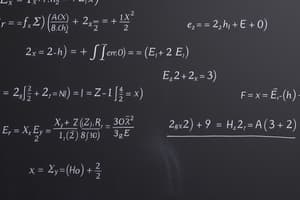Podcast
Questions and Answers
A complex fraction is described as a fraction where only the numerator contains another fraction.
A complex fraction is described as a fraction where only the numerator contains another fraction.
False (B)
When simplifying complex fractions using the LCD method, you should multiply only the numerator of the complex fraction by the LCD of all individual fractions within it.
When simplifying complex fractions using the LCD method, you should multiply only the numerator of the complex fraction by the LCD of all individual fractions within it.
False (B)
To divide two rational expressions, multiply the first expression by the reciprocal of the second expression.
To divide two rational expressions, multiply the first expression by the reciprocal of the second expression.
True (A)
Simplifying rational expressions always results in a numerical value.
Simplifying rational expressions always results in a numerical value.
The expression $\sqrt{x^2 + 4}$ is a rational expression.
The expression $\sqrt{x^2 + 4}$ is a rational expression.
Rationalizing the denominator of $\frac{1}{\sqrt{5}}$ involves multiplying both the numerator and denominator by $\sqrt{5}$.
Rationalizing the denominator of $\frac{1}{\sqrt{5}}$ involves multiplying both the numerator and denominator by $\sqrt{5}$.
The conjugate of $2 + \sqrt{3}$ is $2 - \sqrt{-3}$.
The conjugate of $2 + \sqrt{3}$ is $2 - \sqrt{-3}$.
When adding or subtracting rational expressions, you must first ensure that the expressions have a common radicand.
When adding or subtracting rational expressions, you must first ensure that the expressions have a common radicand.
Restrictions on the variable in a rational expression are values that make the numerator equal to zero.
Restrictions on the variable in a rational expression are values that make the numerator equal to zero.
Simplifying a complex fraction that contains both rational and non-rational expressions always requires rationalizing the denominator as the final step.
Simplifying a complex fraction that contains both rational and non-rational expressions always requires rationalizing the denominator as the final step.
Flashcards
Complex Fraction
Complex Fraction
Fractions with fractions in the numerator, denominator, or both.
LCD Method (Complex Fractions)
LCD Method (Complex Fractions)
Multiply the numerator and denominator of the complex fraction by this value.
Reciprocal Method (Complex Fractions)
Reciprocal Method (Complex Fractions)
Simplify and multiply by reciprocal.
Rational Expression
Rational Expression
Signup and view all the flashcards
Simplifying Rational Expressions
Simplifying Rational Expressions
Signup and view all the flashcards
Multiplying Rational Expressions
Multiplying Rational Expressions
Signup and view all the flashcards
Dividing Rational Expressions
Dividing Rational Expressions
Signup and view all the flashcards
Adding/Subtracting Rational Expressions
Adding/Subtracting Rational Expressions
Signup and view all the flashcards
Non-Rational Expressions
Non-Rational Expressions
Signup and view all the flashcards
Rationalizing the Denominator
Rationalizing the Denominator
Signup and view all the flashcards
Study Notes
There is no new information in the text provided. The document contains exactly the same information as the existing notes.
Studying That Suits You
Use AI to generate personalized quizzes and flashcards to suit your learning preferences.
Description
Understand and simplify complex fractions using the LCD method and reciprocal multiplication. Explore rational expressions and their simplification techniques. Master algebraic fractions.





